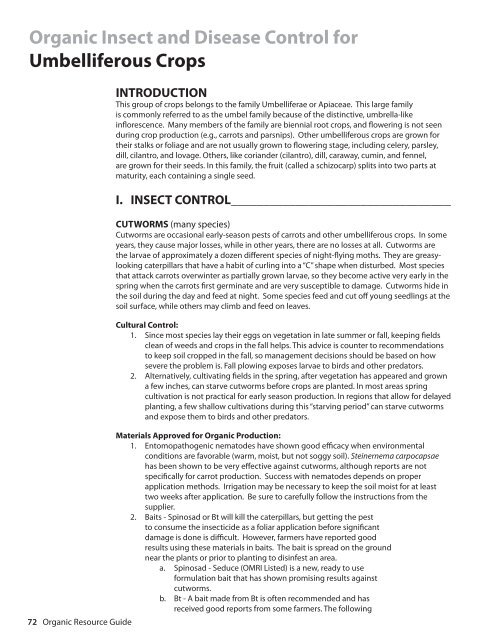Resource Guide for Organic Insect and Disease ... - Cornell University
Resource Guide for Organic Insect and Disease ... - Cornell University
Resource Guide for Organic Insect and Disease ... - Cornell University
Create successful ePaper yourself
Turn your PDF publications into a flip-book with our unique Google optimized e-Paper software.
<strong>Organic</strong> <strong>Insect</strong> <strong>and</strong> <strong>Disease</strong> Control <strong>for</strong><br />
Umbelliferous Crops<br />
72 <strong>Organic</strong> <strong>Resource</strong> <strong>Guide</strong><br />
INTRODUCTION<br />
This group of crops belongs to the family Umbelliferae or Apiaceae. This large family<br />
is commonly referred to as the umbel family because of the distinctive, umbrella-like<br />
inflorescence. Many members of the family are biennial root crops, <strong>and</strong> flowering is not seen<br />
during crop production (e.g., carrots <strong>and</strong> parsnips). Other umbelliferous crops are grown <strong>for</strong><br />
their stalks or foliage <strong>and</strong> are not usually grown to flowering stage, including celery, parsley,<br />
dill, cilantro, <strong>and</strong> lovage. Others, like cori<strong>and</strong>er (cilantro), dill, caraway, cumin, <strong>and</strong> fennel,<br />
are grown <strong>for</strong> their seeds. In this family, the fruit (called a schizocarp) splits into two parts at<br />
maturity, each containing a single seed.<br />
I. INSECT CONTROL__________________________________<br />
CUTWORMS (many species)<br />
Cutworms are occasional early-season pests of carrots <strong>and</strong> other umbelliferous crops. In some<br />
years, they cause major losses, while in other years, there are no losses at all. Cutworms are<br />
the larvae of approximately a dozen different species of night-flying moths. They are greasylooking<br />
caterpillars that have a habit of curling into a “C” shape when disturbed. Most species<br />
that attack carrots overwinter as partially grown larvae, so they become active very early in the<br />
spring when the carrots first germinate <strong>and</strong> are very susceptible to damage. Cutworms hide in<br />
the soil during the day <strong>and</strong> feed at night. Some species feed <strong>and</strong> cut off young seedlings at the<br />
soil surface, while others may climb <strong>and</strong> feed on leaves.<br />
Cultural Control:<br />
1. Since most species lay their eggs on vegetation in late summer or fall, keeping fields<br />
clean of weeds <strong>and</strong> crops in the fall helps. This advice is counter to recommendations<br />
to keep soil cropped in the fall, so management decisions should be based on how<br />
severe the problem is. Fall plowing exposes larvae to birds <strong>and</strong> other predators.<br />
2. Alternatively, cultivating fields in the spring, after vegetation has appeared <strong>and</strong> grown<br />
a few inches, can starve cutworms be<strong>for</strong>e crops are planted. In most areas spring<br />
cultivation is not practical <strong>for</strong> early season production. In regions that allow <strong>for</strong> delayed<br />
planting, a few shallow cultivations during this “starving period” can starve cutworms<br />
<strong>and</strong> expose them to birds <strong>and</strong> other predators.<br />
Materials Approved <strong>for</strong> <strong>Organic</strong> Production:<br />
1. Entomopathogenic nematodes have shown good efficacy when environmental<br />
conditions are favorable (warm, moist, but not soggy soil). Steinernema carpocapsae<br />
has been shown to be very effective against cutworms, although reports are not<br />
specifically <strong>for</strong> carrot production. Success with nematodes depends on proper<br />
application methods. Irrigation may be necessary to keep the soil moist <strong>for</strong> at least<br />
two weeks after application. Be sure to carefully follow the instructions from the<br />
supplier.<br />
2. Baits - Spinosad or Bt will kill the caterpillars, but getting the pest<br />
to consume the insecticide as a foliar application be<strong>for</strong>e significant<br />
damage is done is difficult. However, farmers have reported good<br />
results using these materials in baits. The bait is spread on the ground<br />
near the plants or prior to planting to disinfest an area.<br />
a. Spinosad - Seduce (OMRI Listed) is a new, ready to use<br />
<strong>for</strong>mulation bait that has shown promising results against<br />
cutworms.<br />
b. Bt - A bait made from Bt is often recommended <strong>and</strong> has<br />
received good reports from some farmers. The following







